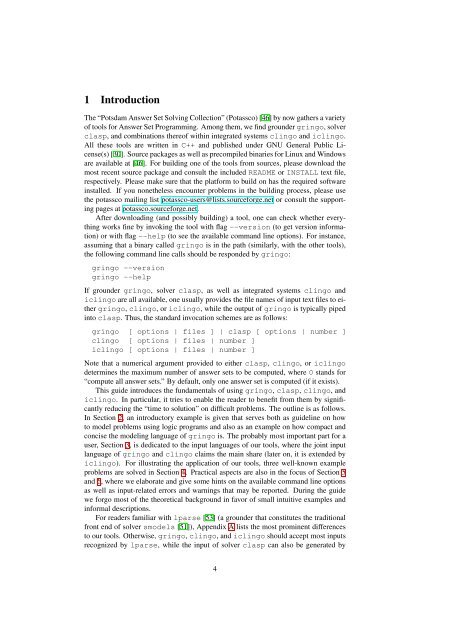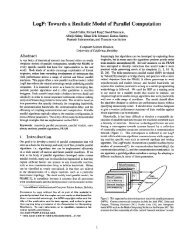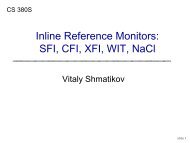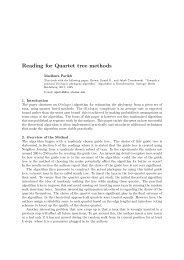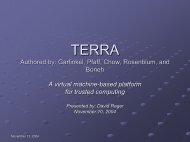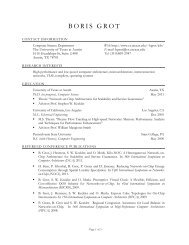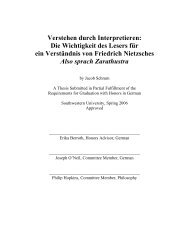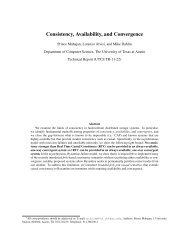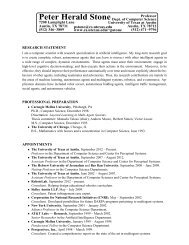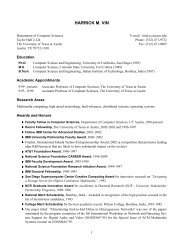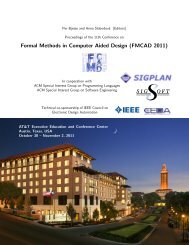A User's Guide to gringo, clasp, clingo, and iclingo
A User's Guide to gringo, clasp, clingo, and iclingo
A User's Guide to gringo, clasp, clingo, and iclingo
Create successful ePaper yourself
Turn your PDF publications into a flip-book with our unique Google optimized e-Paper software.
1 Introduction<br />
The “Potsdam Answer Set Solving Collection” (Potassco) [46] by now gathers a variety<br />
of <strong>to</strong>ols for Answer Set Programming. Among them, we find grounder <strong>gringo</strong>, solver<br />
<strong>clasp</strong>, <strong>and</strong> combinations thereof within integrated systems <strong>clingo</strong> <strong>and</strong> i<strong>clingo</strong>.<br />
All these <strong>to</strong>ols are written in C++ <strong>and</strong> published under GNU General Public License(s)<br />
[30]. Source packages as well as precompiled binaries for Linux <strong>and</strong> Windows<br />
are available at [46]. For building one of the <strong>to</strong>ols from sources, please download the<br />
most recent source package <strong>and</strong> consult the included README or INSTALL text file,<br />
respectively. Please make sure that the platform <strong>to</strong> build on has the required software<br />
installed. If you nonetheless encounter problems in the building process, please use<br />
the potassco mailing list potassco-users@lists.sourceforge.net or consult the supporting<br />
pages at potassco.sourceforge.net.<br />
After downloading (<strong>and</strong> possibly building) a <strong>to</strong>ol, one can check whether everything<br />
works fine by invoking the <strong>to</strong>ol with flag --version (<strong>to</strong> get version information)<br />
or with flag --help (<strong>to</strong> see the available comm<strong>and</strong> line options). For instance,<br />
assuming that a binary called <strong>gringo</strong> is in the path (similarly, with the other <strong>to</strong>ols),<br />
the following comm<strong>and</strong> line calls should be responded by <strong>gringo</strong>:<br />
<strong>gringo</strong> --version<br />
<strong>gringo</strong> --help<br />
If grounder <strong>gringo</strong>, solver <strong>clasp</strong>, as well as integrated systems <strong>clingo</strong> <strong>and</strong><br />
i<strong>clingo</strong> are all available, one usually provides the file names of input text files <strong>to</strong> either<br />
<strong>gringo</strong>, <strong>clingo</strong>, or i<strong>clingo</strong>, while the output of <strong>gringo</strong> is typically piped<br />
in<strong>to</strong> <strong>clasp</strong>. Thus, the st<strong>and</strong>ard invocation schemes are as follows:<br />
<strong>gringo</strong> [ options | files ] | <strong>clasp</strong> [ options | number ]<br />
<strong>clingo</strong> [ options | files | number ]<br />
i<strong>clingo</strong> [ options | files | number ]<br />
Note that a numerical argument provided <strong>to</strong> either <strong>clasp</strong>, <strong>clingo</strong>, or i<strong>clingo</strong><br />
determines the maximum number of answer sets <strong>to</strong> be computed, where 0 st<strong>and</strong>s for<br />
“compute all answer sets.” By default, only one answer set is computed (if it exists).<br />
This guide introduces the fundamentals of using <strong>gringo</strong>, <strong>clasp</strong>, <strong>clingo</strong>, <strong>and</strong><br />
i<strong>clingo</strong>. In particular, it tries <strong>to</strong> enable the reader <strong>to</strong> benefit from them by significantly<br />
reducing the “time <strong>to</strong> solution” on difficult problems. The outline is as follows.<br />
In Section 2, an introduc<strong>to</strong>ry example is given that serves both as guideline on how<br />
<strong>to</strong> model problems using logic programs <strong>and</strong> also as an example on how compact <strong>and</strong><br />
concise the modeling language of <strong>gringo</strong> is. The probably most important part for a<br />
user, Section 3, is dedicated <strong>to</strong> the input languages of our <strong>to</strong>ols, where the joint input<br />
language of <strong>gringo</strong> <strong>and</strong> <strong>clingo</strong> claims the main share (later on, it is extended by<br />
i<strong>clingo</strong>). For illustrating the application of our <strong>to</strong>ols, three well-known example<br />
problems are solved in Section 4. Practical aspects are also in the focus of Section 5<br />
<strong>and</strong> 6, where we elaborate <strong>and</strong> give some hints on the available comm<strong>and</strong> line options<br />
as well as input-related errors <strong>and</strong> warnings that may be reported. During the guide<br />
we forgo most of the theoretical background in favor of small intuitive examples <strong>and</strong><br />
informal descriptions.<br />
For readers familiar with lparse [53] (a grounder that constitutes the traditional<br />
front end of solver smodels [51]), Appendix A lists the most prominent differences<br />
<strong>to</strong> our <strong>to</strong>ols. Otherwise, <strong>gringo</strong>, <strong>clingo</strong>, <strong>and</strong> i<strong>clingo</strong> should accept most inputs<br />
recognized by lparse, while the input of solver <strong>clasp</strong> can also be generated by<br />
4


